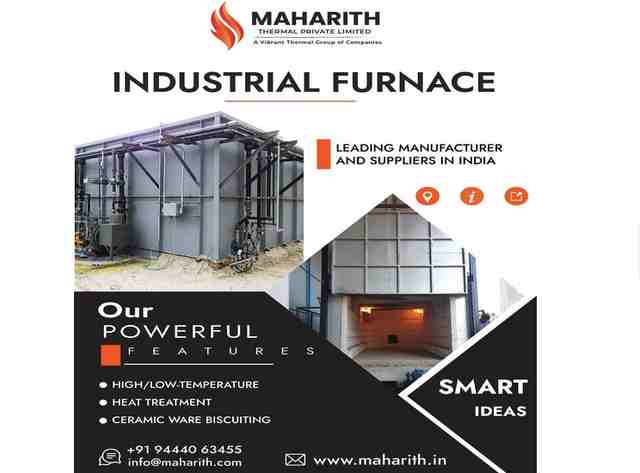From automobile manufacturing to chemicals to sustainable packaging, an industrial furnace is widely employed in different sectors and fields of research. They work with various materials such as solid and powdered metals, organic fibres, ceramics, and others. The top Industrial Furnace Manufacturers in India design and create these furnaces in a variety of sizes and shapes to produce a range of temperatures depending on the application. In this article, we’ll look at what goes into an industrial furnace, and what are its types and applications.
A Brief Introduction to Industrial Furnace
An industrial furnace, also known as a direct-fired heater or a direct heater, generates heat for an industrial process at temperatures more than 400 degrees Celsius. They are used to provide heat for a process or as a reactor for heat processes. Furnace designs vary according to their function, fuel type, heating duty, and manner of injecting combustion air. An industrial furnace produces heat by combining fuel with air or oxygen or by using electricity. The remaining heat will escape as flue gas from the furnace.
They are developed per international regulations and standards, the most common of which are used in the petroleum and natural gas sectors. There are many different types of industrial furnaces, such as batch ovens, vacuum furnaces, and solar furnaces. Industrial furnaces are widely used for a variety of purposes, including cremation, chemical reactions, oil refining, and glassmaking.
How does an Industrial Furnace Work?
Fuel flow enters the burner and is burned with air supplied by air blowers. More than one burner can be prepared in a unique furnace that can be placed in blocks to heat a specific set of tubes. Depending on the design, the burners can be arranged and installed to be wall-mounted, floor-mounted, or roof-mounted. The flames heat the pipes, which heat the fluid inside the furnace’s radiating area, also known as the firebox. Heat is mostly transmitted to tubes near the chamber’s fire through radiation in this cell, where combustion occurs.
The heated fluid circulates through the pipes and is therefore heated to the desired temperature. The combustion gases are referred to as flue gas. Most furnace designs have a convection section where extra heat is collected after the flue gas leaves the firebox and before the flue gas stack releases it into the atmosphere.
Industries also use furnaces to heat a secondary fluid that has specific additives such as anti-rust and exceptional heat transmission efficiency. This heated fluid is then cycled throughout the plant to functionalize exchangers that will be used wherever heat is necessary rather than directly heating the lines since the material or product may be volatile or liable to break at high furnace temperatures.
Different Components and Features of an Industrial Furnace:
An industrial furnace appears simple from the outside, yet it contains several intricate operations. Because of differences in furnace architecture and characteristics, there are several possibilities for heat treatment and thermal processing applications. Most industrial furnaces employ the following common components and technologies:
Chamber Design
Heating and cooling occur in the same chamber in a single-chamber furnace, whereas heating and cooling occur in separate, confined compartments in a double-chamber furnace. To protect temperatures and atmospheres from mingling, a door separates the two compartments.
Atmosphere/Moisture Control
Parts may need to be stored under precise air conditions to encourage or hinder chemical reactions, induce desirable surface changes, or help in lubrication. In these circumstances, a customized chamber can be built to keep a certain chemical at the proper concentration.
Muffles
Muffles are used to separate fuel combustion and heating chambers. This is particularly crucial to avoid contamination from combustion byproducts. They can also be utilized as preheating or cooling zones, or as a storage room for hot materials or parts. Muffles are available in metal or ceramic.
Control Systems
With data collecting and testing software, there are several methods to monitor and change conditions within the furnace. It is also feasible to track performance patterns over time, such as temperature changes, belt speed, or fan speed. Operators can also get reports and notifications, as well as reminders for system testing.
Heat Source
Natural gas combustion, electric boilers, or electrical heating coils can all be used to heat most furnaces. One solution may be more cost-efficient than another depending on the temperature, furnace size, and process time required.
What are the Different Types of Industrial Furnaces?
Annealing Furnace
Annealing is a heat treatment that softens metals so that they may be cold-worked to enhance mechanical, electrical, and other physical qualities. Annealing furnaces reduce internal stress in materials by heating them to their recrystallization temperature, making them ductile for further machining.
Ashing Furnace
Ashing is the technique of determining the weight change of a sample while different components of the sample are burnt away. It is the procedure of eliminating biological material before analyzing it. The process includes the total burning of the substance being evaluated.
Bell Furnace
Bell furnaces are batch heat treatment furnaces that may sinter or dry materials. Inside an enclosed dome, the load is heated. When the workload is high, bell furnaces are required. They are not suitable for small batch production and are driven by electricity, gas, or a thermal circulation system.
Box Industrial Furnace
Heat treatment, curing, annealing, preheating, and tempering are all done in box furnaces. They feature a very simple design that allows them to be incredibly adaptable and trouble-free. Box furnaces are available with single or multiple-zone heating with temperatures ranging from 1000° C to 1700° C. They are available in a variety of shapes and sizes, ranging from tabletop units to massive heavy-duty multi-level models.
Parting Words
The team at Maharith Thermal Pvt. Ltd. utilizes its years of combined research and engineering knowledge to manufacture industrial furnaces, heaters, and ovens. Being one of the top Industrial Furnace Suppliers in India, we are doing our best to provide you with high-quality products. We can collaborate with you to understand your requirements and design the best Industrial Oven and furnace that fulfils your specific industrial needs. Visit our website to get more information about our furnaces and ovens.


